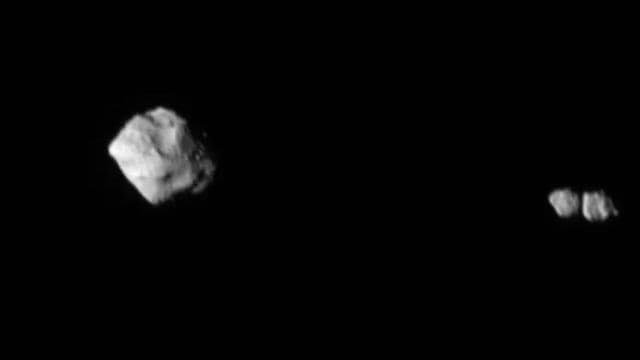Dinkinesh surprises NASA’s Lucy mission again: 3 asteroids instead of 1
NASA's Lucy mission has unveiled another surprise from Dinkinesh. Dinkinesh is a total of three asteroids, not two.
 This image of the asteroid Dinkinesh and its satellite was taken 6 minutes after Lucy's close approach. (NASA/Goddard/SwRI/Johns Hopkins APL)
This image of the asteroid Dinkinesh and its satellite was taken 6 minutes after Lucy's close approach. (NASA/Goddard/SwRI/Johns Hopkins APL) The asteroid Dinkinesh already surprised astronomers once when NASA’s Lucy mission flew past it. What was thought to be a single asteroid turned out to be a binary system of two asteroids. The space agency on Tuesday said that one of those space rocks in a pair is in itself a contact binary. This means that the asteroid is not two but a total of three different space rocks.
A contact binary refers to two small separate objects that are touching each other. In the first images of Dinkinesh downloaded from the Lucy spacecraft, the two parts of the contact binary happened to be one behind another. This meant that it looked like there was only one “moon” there. After the Lucy team downlinked more images, some taken minutes after the encounter, they realised that it was actually another contact binary.
“Contact binaries seem to be fairly common in the solar system. We haven’t seen many up close, and we’ve never seen one orbiting another asteroid. We’d been puzzling over odd variations in Dinkinesh’s brightness that we saw on approach, which gave us a hint that Dinkinesh might have a moon of some sort, but we never suspected anything so bizarre!,” said John Spencer, Lucy mission’s deputy project scientist, in a press statement.
 This is how Dinkinesh appeared during the initial flyby (NASA/Goddard/SwRI/Johns Hopkins APL/NOAO)
This is how Dinkinesh appeared during the initial flyby (NASA/Goddard/SwRI/Johns Hopkins APL/NOAO)
The Lucy mission was designed to survey the Jupiter Trojan asteroids. The Trojans are a group of asteroids that travel on Jupiter’s orbit in two “swarms.” One swarm leads the gas giant in its orbit, and another follows the planet. The encounter with Dinkinesh, which is in the main asteroid belt between Mars and Jupiter’s orbits, was only added in January 2023.







